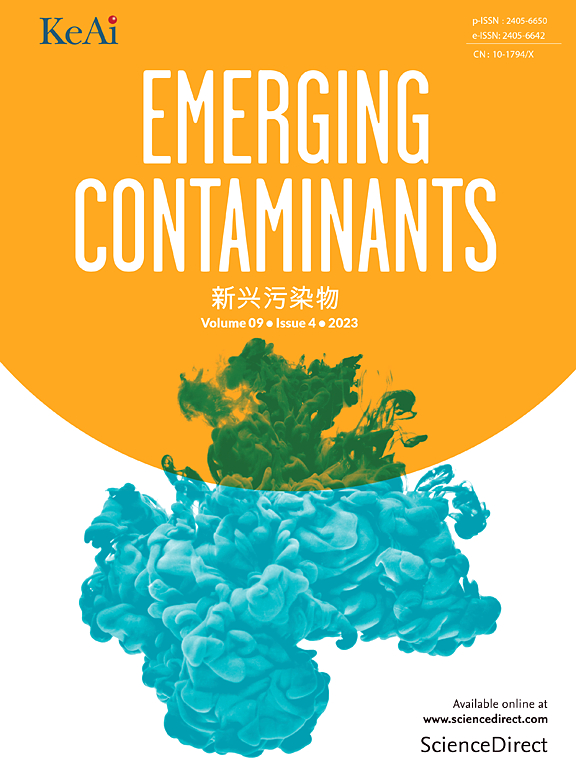Tackling per- and polyfluorinated alkyl substances in the North African Environment: Slight progress amidst significant challenges
IF 6.9
2区 环境科学与生态学
Q1 ENVIRONMENTAL SCIENCES
引用次数: 0
Abstract
Per- and polyfluoroalkyl substances (PFAS) have attracted global attention due to their persistence, potential for bioaccumulation, and adverse effects on both human health and the environment. However, the extent and implications of PFAS contamination in North Africa remain insufficiently explored. This review addresses this regional knowledge gap by critically evaluating the occurrence, sources, and potential impacts of PFAS in environmental and human matrices across North Africa. Based on a comprehensive review of credible scientific sources, this analysis consolidates evidence of PFAS contamination across various environmental and human matrices. All examined matrices, including water, biota, air, foodstuffs, food packaging materials, and human samples, were contaminated by at least one PFAS compound. Potential sources of PFAS are discussed in relation to the known applications of specific compounds. Although PFAS levels reported in the North African environment are generally lower than those observed in more urbanized and industrialized countries, the findings clearly demonstrate the presence and widespread distribution of PFAS in the region. Notably, fish livers collected from Sudan exhibited the highest PFAS concentrations, with perfluorooctane sulfonic acid (PFOS) levels reaching up to 331 ng g−1 wet weight (ww), substantially exceeding the recommended Environmental Quality Standard (EQS) for PFOS in biota set at 9 ng g−1 ww. Identified sources of PFAS contamination include both industrial activities (e.g., manufacturing discharges, aqueous film-forming foams) and consumer-related sources (e.g., municipal landfills, electronic waste, port operations, and precursor degradation). Although toxicological assessments currently suggest a generally low risk to human and ecological health, this may be due to limited monitoring data rather than an actual absence of PFAS. Overall, this review enhances the regional understanding of PFAS pollution in North Africa, highlights critical data gaps, and outlines priorities for future research and policy development aimed at monitoring, regulating, and mitigating PFAS exposure in the region.

处理北非环境中的全氟和多氟烷基物质:在重大挑战中取得微小进展
全氟和多氟烷基物质(PFAS)由于其持久性、潜在的生物蓄积性以及对人类健康和环境的不利影响而引起了全球的关注。然而,在北非,全氟辛烷磺酸污染的程度和影响仍未得到充分探讨。本综述通过批判性地评估PFAS在北非环境和人类基质中的发生、来源和潜在影响,解决了这一区域知识差距。基于对可靠科学来源的全面审查,本分析整合了PFAS在各种环境和人体基质中污染的证据。所有被检测的基质,包括水、生物群、空气、食品、食品包装材料和人类样本,都被至少一种PFAS化合物污染。根据已知的特定化合物的应用,讨论了PFAS的潜在来源。尽管在北非环境中报告的PFAS水平通常低于在城市化和工业化程度较高的国家所观察到的水平,但研究结果清楚地表明PFAS在该区域的存在和广泛分布。值得注意的是,从苏丹收集的鱼肝脏显示出最高的全氟辛烷磺酸浓度,其全氟辛烷磺酸(PFOS)含量高达331 ng g - 1湿重(ww),大大超过了生物群中全氟辛烷磺酸建议的环境质量标准(EQS),该标准设定为9 ng g - 1 ww。已确定的PFAS污染来源包括工业活动(例如,制造业排放,水性成膜泡沫)和与消费者相关的来源(例如,城市垃圾填埋场,电子废物,港口作业和前体降解)。虽然目前的毒理学评估表明,对人类和生态健康的风险普遍较低,但这可能是由于监测数据有限,而不是由于实际没有PFAS。总体而言,本综述加强了对北非PFAS污染的区域理解,突出了关键的数据缺口,并概述了未来研究和政策制定的重点,旨在监测、调节和减轻该地区PFAS暴露。
本文章由计算机程序翻译,如有差异,请以英文原文为准。
求助全文
约1分钟内获得全文
求助全文
来源期刊

Emerging Contaminants
Medicine-Public Health, Environmental and Occupational Health
CiteScore
10.00
自引率
6.70%
发文量
35
审稿时长
44 days
期刊介绍:
Emerging Contaminants is an outlet for world-leading research addressing problems associated with environmental contamination caused by emerging contaminants and their solutions. Emerging contaminants are defined as chemicals that are not currently (or have been only recently) regulated and about which there exist concerns regarding their impact on human or ecological health. Examples of emerging contaminants include disinfection by-products, pharmaceutical and personal care products, persistent organic chemicals, and mercury etc. as well as their degradation products. We encourage papers addressing science that facilitates greater understanding of the nature, extent, and impacts of the presence of emerging contaminants in the environment; technology that exploits original principles to reduce and control their environmental presence; as well as the development, implementation and efficacy of national and international policies to protect human health and the environment from emerging contaminants.
 求助内容:
求助内容: 应助结果提醒方式:
应助结果提醒方式:


